You can get great results from hair oils, but only if you use them properly. Excessive use may clog your hair follicles and cause scalp buildup, and not using them enough may cause dryness. You have come to the right place if you want to know how to apply oil to hair effectively. Oiling your hair may help boost hair growth, keep it moisturized, add shine, prevent frizz and dry scalp problems. Therefore, it is necessary to know how to oil your hair correctly. The following article provides a comprehensive guide to oiling your hair. Read on for more information.
In This Article
Why Should You Oil Your Hair?
Just like your skin needs moisturization, your scalp and hair need oils to stay healthy and moisturized. Hair oils contain essential nutrients that lubricate the hair follicles, provide moisture to the shafts, and keep them healthy. Oiling the hair enhances its growth, nourishes the roots, tames frizz, protects the hair from environmental stressors like dust, UV rays, and pollution, and prevents dryness. However, to reap the maximum benefits, you have to apply hair oils the right way.
How To Oil Your Hair Effectively: The 6 Steps
Step 1: Choose The Right Carrier Oil For Your Hair Type
Ensure that you are using the right carrier oil for your hair type. These oils can be used alone or with essential oils. Coconut, almond, jojoba, olive, sunflower, grapeseed, primrose, borage, and avocado oils are commonly used carrier oils. If you have a greasy scalp, use light oils like grapeseed and almond oils. Heavy oils, such as coconut, olive, and jojoba, are best for dry scalp and hair.
Tip: Brush your hair before oiling to get rid of all the knots and tangles. This will make the oil application process easy.
Step 2: Choose Your Favorite Essential Oil
Essential oils can help target specific scalp concerns like dry or flaky scalp. They promote hair growth and add shine and strength to your tresses. These are pure oils that capture the “essence” of the plant. You can choose them based on their properties and your hair type.
You can pick from oils like tea tree, lavender, peppermint, rose, jasmine, lemon, and sandalwood essential oils. These are highly concentrated and must be diluted in carrier oils. For 2.5% dilution, use 15 drops of essential oil per 6 teaspoons of carrier oil. For 3% dilution, add 20 drops of essential oil to 6 teaspoons of carrier oil. It is best to start from the lowest ratio.
Tip: Do a patch test to avoid any allergic reactions.
Step 3: Heat The Oil
No matter what your hair type is, you must heat the hair oil for a few seconds until it is warm. This allows for deeper penetration and seals the hair cuticles to keep the scalp moisturized. Ensure that the oil is not be heated directly. Instead, warm it over hot water.
Tip For Easy Application: Section your hair into two parts for easy application. Pour one teaspoon of oil on your palm and spread it well using your fingertips.
Step 4: Massage Your Scalp
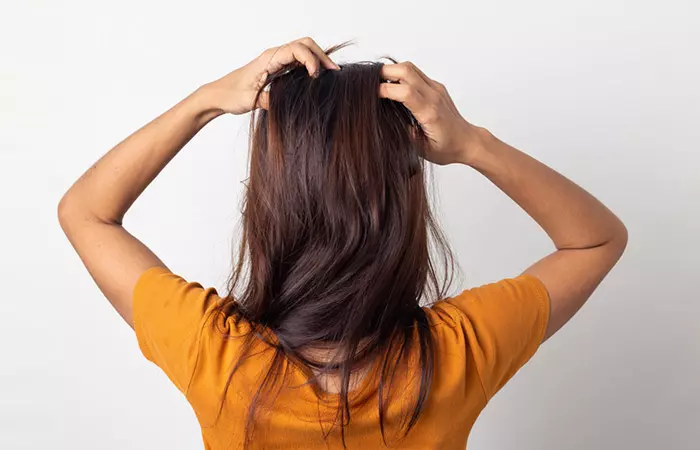
Shutterstock
Massaging the scalp stimulates the hair follicles and boosts blood circulation to the scalp (1). It also relieves headaches and promotes relaxation.
Massage the oil onto your scalp gently for 10-15 minutes. Use your fingertips to massage in circular motions and gently rub the oil and cover the entire scalp area. After you are done with the scalp, apply it up to the ends of your hair.
Step 5: Wrap Your Hair With A Warm Towel

Shutterstock
Wrapping your hair in a warm towel promotes deeper penetration of the oils into your scalp and hair. It helps rejuvenate dry and damaged hair and also seals moisture in your hair.
Tip: Do not tie or wrap your hair tightly as it may cause breakage.
Step 6: Rinse It Off Well
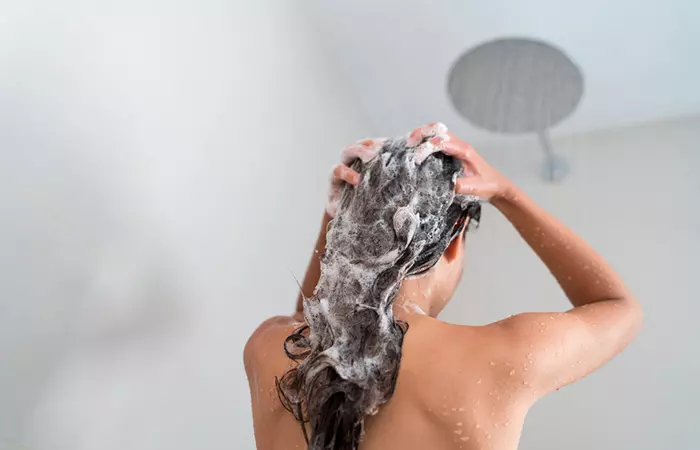
Shutterstock
Let your hair soak the oil for 1-2 hours. Wash it off with a mild shampoo. Do not leave it on for a long time as your hair will start attracting dirt. Use regular or cold water to rinse your hair.
While applying oil, you may notice some hair fall. Is it something to worry about? Find out in the next section.
Why Do You Observe Hair Fall After Oiling?
Oiling and massaging the hair may cause the weak strands to fall off, and this is a common phenomenon. On average, you may lose 50-100 strands every day. As long as the hair fall rate is normal, there is no need to be concerned. After oiling, you should leave it on for a certain time to let the hair and scalp absorb it. Washing it off earlier may not serve the purpose.
How Long To Leave Oil On The Hair
Not all hair types require the same amount of time to absorb oil. However, as a rule of thumb, you should not leave it for more than 2-4 hours on your hair. You may wash it off on the same day. However, make sure to keep it on for at least 1-2 hours. Also, never apply oil to dirty hair.
What Happens When We Oil Dirty Hair?
When you apply oil to dirty hair and scalp, the oil further clogs the scalp pores, trapping the dirt. Dirty hair and scalp cannot soak the goodness of the oil, and your hair becomes prone to breakage. You can apply oil to both wet and dry hair. However, the results will be different.
Subscribe
Oiling Wet Hair Or Dry Hair – Which One Is The Best?
If you apply oil to wet hair, water will repel it and not allow the oil to penetrate through follicles. However, oiling wet hair allows better detangling and offers protection from heat styling tools. Applying oil on dry hair adds shine and protects the hair from UV rays and pollution. Moreover, dry hair can absorb oil effectively. However, you should be careful about the frequency and quantity of oil used.
Does Too Much Oil Damage The Hair?
The scalp produces natural oils to lubricate the hair and maintain hair health. Applying too much oil on the scalp disturbs this natural cycle and makes your hair greasy. Heavy oiling can clog the pores and choke the scalp, preventing hair growth and causing hair fall.
Using hair oils properly may help resolve several hair-related issues. The article here has discussed how to apply oil on hair properly. Though oiling may boost hair growth, maintain its moisture, improve the shine, and prevent dry and frizzy scalp issues, you must follow the right application procedure to reap maximum benefits. Excessive use, as well as not using them enough, may harm your hair health. Massaging your scalp with oil once or twice a week promotes relaxation and boosts hair growth.
Frequently Asked Questions
When should we apply oil to hair?
You should apply oil to clean wet or dry hair. Oiling dirty hair can increase buildup and cause hair damage.
Can I apply oil daily on my hair?
Yes, you can oil your hair daily, especially if you have dry, damaged, or weak hair. Avoid regular oiling if you have acne-prone or oily skin and scalp.
Do you oil before or after washing hair?
You can apply oil before washing your hair and leave it on for an hour or overnight.
How many times should I oil my hair in a week?
Oil your hair once or twice a week if you have oily or normal hair. If you have dry hair, you can oil your hair more frequently.
Key Takeaways
- Choosing the right essential and carrier oils is the first step towards achieving healthy and well-nourished hair.
- Using the right amount of oil is crucial for preventing your scalp from choking.
- Moreover, leaving the oil for longer periods must be avoided as your strands can get greasy and attract dirt.
- Hair fall while applying oil is common. Do not avoid oiling hair for this reason.
Sources
Stylecraze has strict sourcing guidelines and relies on peer-reviewed studies, academic research institutions, and medical associations. We avoid using tertiary references. You can learn more about how we ensure our content is accurate and current by reading our editorial policy.
- Standardized Scalp Massage Results in Increased Hair Thickness by Inducing Stretching Forces to Dermal Papilla Cells in the Subcutaneous Tissue
https://www.ncbi.nlm.nih.gov/pmc/articles/PMC4740347/
Related
The following two tabs change content below.
- Author
- Reviewer

Arshiya Syeda
Arshiya Syeda is an editor at StyleCraze. Prior to that, she was a content writer and combined her writing and… more
Dr. Aparna K
(BAMS, MD, PhD (Ayurveda))Dr. Aparna belongs to an Ayurveda family that operates a traditional Ayurveda panchakarma hospital in Kerala, India. She grew up… more



 How To Use Jamaican Black Castor Oil For Hair Growth
How To Use Jamaican Black Castor Oil For Hair Growth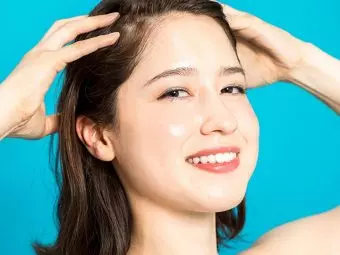 How To Exfoliate Your Scalp At Home To Clear Excess Oil
How To Exfoliate Your Scalp At Home To Clear Excess Oil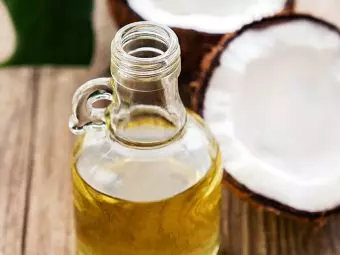 How To Use Coconut Oil For Dry Scalp And Dandruff
How To Use Coconut Oil For Dry Scalp And Dandruff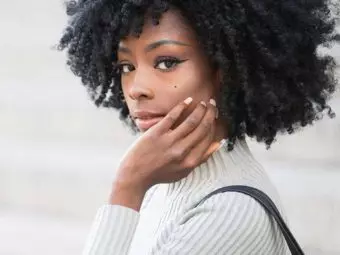 Easy Way To Get The Perfect Twist Out On 4C Natural Hair
Easy Way To Get The Perfect Twist Out On 4C Natural Hair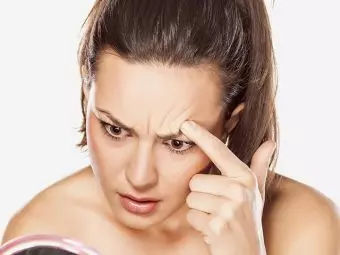 Eyebrow Hair Loss: Causes, Prevention Tips, & DIY Methods
Eyebrow Hair Loss: Causes, Prevention Tips, & DIY Methods Types Of Hair Loss, Causes, Treatments, & Prevention Options
Types Of Hair Loss, Causes, Treatments, & Prevention Options Itchy Scalp And Hair Loss: How To Treat And How To Prevent It
Itchy Scalp And Hair Loss: How To Treat And How To Prevent It What Is Hair Texturizing? How To Take Care Of Texturized Hair?
What Is Hair Texturizing? How To Take Care Of Texturized Hair? Is It Safe To Wash Hair With Soap?
Is It Safe To Wash Hair With Soap?